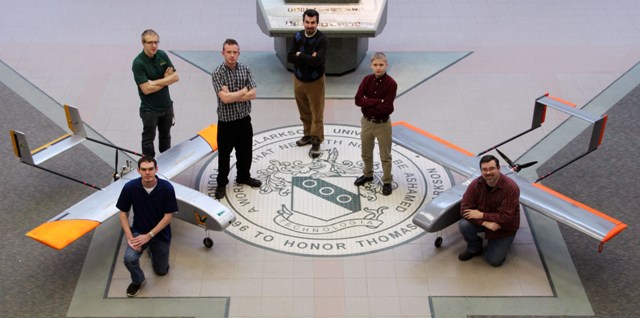May 8 2014
Clarkson University has added another Unmanned Aerial Vehicle (UAV) to its Unmanned Aerial Systems (UAS) research team. The Golden Eagle II (GE2), originally designed to be a teaching tool, will begin its life as a research-advancing aircraft this summer.
 Clarkson University has added another Unmanned Aerial Vehicle (UAV) to its Unmanned Aerial Systems research team. The Golden Eagle II (right) joins the Golden Eagle I (left). Above, (left to right) John Whiddon, Barry Pawlowski, Jacob Miller, Pier Marzocca, Ryan Feldman and Dan Valyou.
Clarkson University has added another Unmanned Aerial Vehicle (UAV) to its Unmanned Aerial Systems research team. The Golden Eagle II (right) joins the Golden Eagle I (left). Above, (left to right) John Whiddon, Barry Pawlowski, Jacob Miller, Pier Marzocca, Ryan Feldman and Dan Valyou.
Recently the Federal Aviation Administration selected six unmanned aircraft systems (UAS) research and test site operators across the country. Clarkson University is part of the Northeast UAS Airspace Integration Research Alliance (NUAIR, http://www.nuair.org), a regional alliance of private industry, academic institutions and military assets and operations, working together to establish one of the FAA designated test site for UAS in the Northeast, based in New York and Massachusetts. This site will conduct testing and research in order to begin to safely integrate unmanned vehicles and systems into the National Airspace System.
“It is an exciting time," says Pier Marzocca, a professor in the Department of Mechanical and Aeronautical Engineering and UAS mission commander. "We will be able to further explore the potentials of using our UAS for research and will provide support for the commercial development of technologies from sense and avoid, to command and control, helping the safe integration of UAS into the complex air traffic systems, and the development of a variety of scientific payload."
The GE2 project began as upgraded components for its older sister the Golden Eagle I (GE1, http://www.clarksonuniversityuav.blogspot.com). Primarily designed, analyzed, and constructed by Clarkson undergraduate students, its value as a teaching aid has exceeded expectations.
Clarkson students were introduced to a wide range of useful skills and experiences. Discussion of basic aircraft components, fundamentals of flight, and composite fabrication were a common subject over summer build sessions. More experienced students acted as team leaders and played a role in the performance analysis of the UAV.
During the GE2 design, the digital version of GE1 created with X-Plane ver. 10 was used. By improving the fidelity of the X-Plane model the GE1’s flight model performance was matched to recorded aircraft performance data. Further improvements were made to enhance the flight characteristics of the GE1 which led to the GE2.
“If this simulation model remains accurate, this new plane will want to jump off the ground," says project leader and Jacob Miller '14 of Warsaw, N.Y.
From June 2013 on the team geared up to fabricate the new platform.
The new aircraft was designed to be an improvement across the board over the GE1. It can carry nearly twice the payload, has a higher cruise speed, and is predicted to be more stable. This was done while maintaining the same weight as the GE1.
Field testing is expected to begin this summer. As research advancing aircraft, the Clarkson Unmanned Aerial Systems research team has several prospects that are under consideration for this summer and the continuing years.
Upcoming projects include measuring environmental conditions and mapping turbulence above a small Adirondack lake, surveying the Long Island Sound ecosystem to support its environmental management, and a project to map ice thickness in the Arctic.
In addition to Marzocca and Miller, team members include Ryan Feldman '15 of Rodman, N.Y., Barry Pawlowski '14 of Cheektowaga, N.Y., John Whiddon '15 of Spencer, N.Y., and Dan Valyou, Clarkson blade test facility manager.
Clarkson University launches leaders into the global economy. One in five alumni already leads as a CEO, VP or equivalent senior executive of a company. Located just outside the Adirondack Park in Potsdam, N.Y., Clarkson is a nationally recognized research university for undergraduates with select graduate programs in signature areas of academic excellence directed toward the world’s pressing issues. Through 50 rigorous programs of study in engineering, business, arts, sciences and health sciences, the entire learning-living community spans boundaries across disciplines, nations and cultures to build powers of observation, challenge the status quo, and connect discovery and engineering innovation with enterprise.